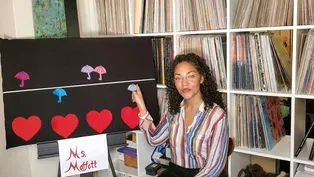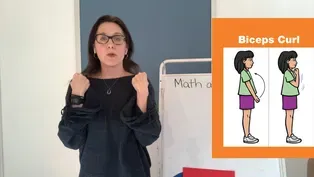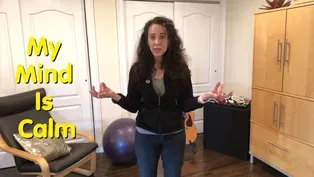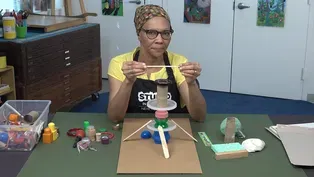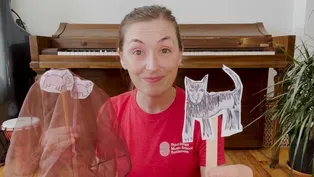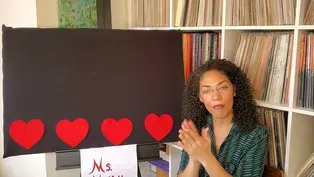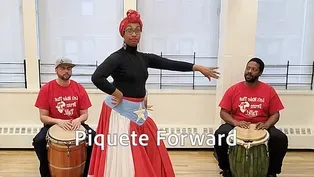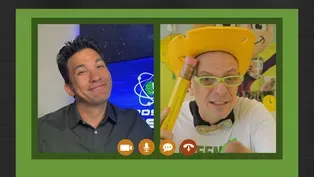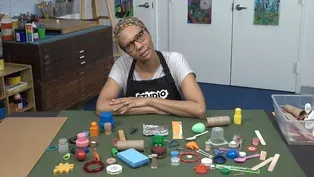
Which is Heavier: One Apple or Two Apples?
5/25/2021 | 58m 5sVideo has Closed Captions
Defy gravity, learn secret code words for fast and slow in music, read WHOOO KNEW?
Defy gravity, learn secret code words for fast and slow in music, compare by weight, read WHOOO KNEW?, review final blends nk, ng; inflection-ing and -s and -es. LET’S LEARN helps children ages 3-8 with at-home learning. One-hour programs feature instruction by educators and virtual field trips.
Problems with Closed Captions? Closed Captioning Feedback
Problems with Closed Captions? Closed Captioning Feedback
Let's Learn is a local public television program presented by THIRTEEN PBS

Which is Heavier: One Apple or Two Apples?
5/25/2021 | 58m 5sVideo has Closed Captions
Defy gravity, learn secret code words for fast and slow in music, compare by weight, read WHOOO KNEW?, review final blends nk, ng; inflection-ing and -s and -es. LET’S LEARN helps children ages 3-8 with at-home learning. One-hour programs feature instruction by educators and virtual field trips.
Problems with Closed Captions? Closed Captioning Feedback
How to Watch Let's Learn
Let's Learn is available to stream on pbs.org and the free PBS App, available on iPhone, Apple TV, Android TV, Android smartphones, Amazon Fire TV, Amazon Fire Tablet, Roku, Samsung Smart TV, and Vizio.
Providing Support for PBS.org
Learn Moreabout PBS online sponsorshipMore from This Collection
Video has Closed Captions
Read SCHOOL BUS and draw one, learn about prefixes and pitch, build sculptures. (57m 48s)
Running and Counting Both End in “ing”!
Video has Closed Captions
Move to improve, find the missing number, learn songs from Ghana, read ABUELITA’S SECRET. (58m 17s)
What Sound Does “aw” Make in Draw?
Video has Closed Captions
Read a story, discover "au" and "aw," learn about density, count, and move with music. (56m 58s)
Can You Find the Short “u” in Subtract?
Video has Closed Captions
Help Super Grover 2.0 solve a prickly problem, read ALL THE WAYS TO BE SMART. (56m 19s)
What Sound Does “gl” Make in Glove?
Video has Closed Captions
Play the glockenspiel, help Super Grover 2.0 make a cart move, read TWO WOOL GLOVES. (58m 9s)
Incredible Starts with Short “i”!
Video has Closed Captions
Solve problems with Super Grover 2.0, catch a rainbow, hear a piano sound like a cuckoo. (56m 9s)
What’s the Sound of “oo” in Book?
Video has Closed Captions
Explore animals’ form and function, sing about the 3 little pigs, read THE LITTLE BOX. (58m 15s)
We’re Reducing, Reusing and Recycling!
Video has Closed Captions
Learn all about rhythm and the number 9, read A BAG IN THE WIND. (56m 17s)
Video has Closed Captions
Learn to dance bomba and grow food in a city, read WOLF CUB’S SONG. (55m 20s)
How Many Syllables are in Invent?
Video has Closed Captions
Invent your own instrument, make 10 to add numbers to 20, read ONE GOLDEN RULE AT SCHOOL. (57m 36s)
Video has Closed Captions
Learn about the science behind mind reading, count shells, read MY BIG FAMILY. (57m 27s)
What’s the Sound of “nk” in Think?
Video has Closed Captions
Make beautiful stuff, learn all about the number 8, read LITTLE BUNNY’S BALLOON. (58m 44s)
Providing Support for PBS.org
Learn Moreabout PBS online sponsorship- [Narrator] Ready to learn?
- [Both Together] Hi.
- [Narrator] It's time to share a story.
- Shh.
- [Narrator] Read and write.
- Let's read it back.
- [Narrator] Discover science, sing.
- Somewhere.
- [Narrator] Play and so much more.
- Cupcake.
- Very good.
- [Narrator] Stay tuned for lessons and activities.
- We're gonna start making some words, isn't that fun?
[playful music] - [Narrator] Funding for this program was provided by The JPB Foundation.
[playful music] - Hello friends.
My name is Annette Whipple and I think facts are fun.
I like to learn about new things and sometimes I even write about them in the books that I write for kids like you.
That means that I'm an author.
But sometimes I hear or see something in nature, like Wilbur, Wilbur's waving a wing to you, do you want to wave a wing to Wilbur?
Oh yeah, sometimes I see or hear something in nature that makes me curious and I just want to know more about it.
And that is how I wrote the book "Whooo Knew?
The Truth About Owls".
I thought I would read to you some of the pages from "Whooo Knew?
The Truth About Owls".
Wilbur, I'm going to put you down, so I can read to the children.
Will you listen, too?
Wilbur's going to listen, too.
I think he'll put on his owl ears.
"Whooo Knew?
The Truth About Owls", by me, Annette Whipple.
Who's there?
The unforgettable call.
The glowing eyes.
The fierce beak.
You recognize an owl when you hear or see one, but do you really know these birds?
Let's look to see what this owl is saying.
Who knew?
Did you think owl just hoo?
Nah, we make lots of sounds.
Listen for screeches, whistles, trills and even barks.
You can know our species by our sounds.
I don't want you to see me, but you may hear me near a forest.
Other owls live in deserts, rainforests and the tundra.
We're owl over the world, even in cities.
I sleep at night.
When do you sleep?
I wonder if owls sleep at the same time as us?
Let's find out.
Do owls sleep all day?
During the day, most owls nap and hide in their roost.
They're active at night.
But not all owls are nocturnal.
Some owls are active at dawn and dusk.
The burrowing owls hunt around sunrise and sunset, so they rest during the day and night.
Northern Hawk Owls are different from most owls.
They spend their days awake and hunting.
They nap at night.
Like you and me.
Who knew?
I'm a snowy owl.
Summer days in the Arctic are long, so I find plenty of small mammals, like lemmings, while the sun shines.
I even hunt birds and fish.
Owls must be aware of danger, so we don't sleep deeply.
Instead, we nap whenever we can.
Oh boy.
All birds have feathers on their bodies, they cover the bird.
But, for an owl, what good are feathers?
Let's find out.
Feathers cover owls' bodies.
Each kind of owl has its own color and pattern to help it hide.
It's called camouflage, and it helps owls blend in with their surroundings.
Look at this owl.
Oh, it's on a tree.
We're close enough in this photograph that we can see the owl, but if we were further away, we might not be able to see it.
That's camouflage.
The feathers help the owl to hide.
Like all birds, feathers help owls fly.
But the feathers of owls are different from other birds.
Most owls fly without a sound because of their soft and jagged wing feathers.
Who knew?
Hee, hee, hee.
Did I scare you?
We puff up our feathers when we're spooked.
Don't get too close because we like to keep some secrets.
Scientists don't know everything about us yet.
What good are ear tufts?
Some owls have ear tufts at the top of their heads, but those are not ears at all, they're just feathers.
Owls show their mood with ear tufts.
A watchful owl keeps his ear tufts raised, an irritated and grumpy owl lays them flat.
Male and female owls even communicate with ear tufts during courtship.
Owls' actual ears are on the sides of their heads.
These openings hide under feathers.
They hear the softest of sounds, like a mouse's footsteps.
Once an owl locates a sound, she knows where to find her prey.
Who knew?
All owls have incredible hearing, but my barn owl friends have unusually large ear structures and exceptional hearing.
Many of us have one ear higher than the other, which helps us to target our prey, then dinnertime.
Who endangers or hurts owls.
Many owlets don't live through their first year of life.
Disease and starvation put young owls in danger.
Predators threaten owls, too.
Animals, like raccoons and foxes, often prey on owl eggs and owlets, the baby owls.
Larger owls and hawks also hunt owls, even adult owls.
Yet, many owlets grow up with the unforgettable call, the glowing eyes, the fierce beak.
And that's the truth about owls.
If you have more questions about owls, you might find answers in other pages in the book.
Here, you can see the anatomy of an owl.
And you can even dissect an owl pellet, which shows you what they had for dinner.
I wondered if you would like to pretend to be an owl with me, would you do that?
Owls have ears on the sides of their heads.
One ear is higher than the other and that helps them to hear well.
But there's something else that helps them to hear really well, too.
Around the large eyes of an owl are these circles, they're called facial discs, and those facial discs help put sound inside the owls ears.
Kind of like what our ears do.
See how our ears are a little bit shaped, not quite like a circle, but maybe a little bit?
Well, can you put your fingers together like this?
Let's cup our hands together and then put them behind our ears and push our ears forward.
I call these owl ears because they help us to hear even better.
Now, let's listen and see if we can hear some sounds.
Let's listen with our owl ears on.
[owl hooting] Did you hear that?
Wow.
Let's listen one more time.
This time, let's put our owl ears on, pushing our ears forward and then take them off and put them on again, and see if we can tell how it helps us to hear.
Let's listen one more time and see what we hear.
[owl hooting] Wow.
Did you hear that, too?
Nature is amazing.
And I hope that you will stay curious, kind of like Wilbur and I are.
We are curious because we like to learn new things.
And books can really help us to be curious, can't they?
They can.
And, you know, when I was researching about spiders for my, one of my next books, called "Scurry: The Truth About Spiders!
", I met a real spider and I got to hold it.
And inside this box is not a moving, living spider, but I want to show you what's inside.
Take a look.
This is the exoskeleton of a spider.
Just like if we cut our hair off, that hair is not alive anymore, because this is just the outer skin of a spider, it's not alive anymore.
Spiders shed their skin, or their exoskeleton, when their exoskeleton gets to be too small.
Just like we take off our clothes and we don't wear, if our socks get too small for us, we stop wearing them and we get bigger socks.
That's what spiders do, too.
One thing that amazed me when I was learning about spiders is that the hairs on their bodies help them sense their world.
Just like we have our sight, our smell, our hearing, our taste, and our touch, well, spiders sense their world mostly through the hairs on their bodies.
I think that's pretty cool.
Sometimes, we might not be comfortable with something, like spiders, until we learn more about them.
But, reading books and going out into nature can help us enjoy these things even more.
Friends, I hope you will be curious and read lots of books, ask lots of questions, because that's how we celebrate our curiosity.
Happy reading, friends.
- Hi, movers and shakers.
This is Violet and I'm here with my little sister, Ivy.
- Hi.
- And we have a song for you today that also has a game and it's called The Name Game.
So, we're gonna sing it for you.
Who's name should we use first?
- Let's do yours.
- Okay.
All right, ready?
- Yup.
♪ Violet, Violet, bo biolet, ♪ ♪ Banana fanna, fo fiolet, ♪ ♪ Me, my, mo miolet, ♪ ♪ Violet ♪ - Did you catch that?
All right, let's try it with your name now.
- All right.
- All right, ready?
- Mm hmm.
♪ Ivy, Ivy, bo bivy ♪ ♪ Banana fanna, fo fivy ♪ ♪ Me, my, mo mivy, ♪ ♪ Ivy ♪ - Have you ever heard of this song?
It's a funny one.
And can you hear the pattern?
I wonder if you can do it with your own name.
So, how it works is you start with your name and if your name doesn't start with a vowel, like mine, you replace the first sound with a different sound for each part of the song.
So, first, we say our name, in my case, Violet, and then, every time after that, we're going to change the first sound.
First, with a ba sound, with a B, then with fa sound, an F, and then, lastly, a mm sound, mm, with the sound M makes, right?
Mm.
So, it's Violet, biolet, fiolet, - [Both Together] Miolet.
[laughing] And Ivy's name starts with a vowel and so, instead of switching the first sound, you just add the first sound in front of it.
So, what would your name be, then, for the sounds?
- So, it's Ivy, - Mm hmm.
- bivy, fivy, mivy.
- Isn't that silly?
All right, we're gonna sing it once again, slowly, with each of our names and then, we want to hear you sing it with your own name.
All right?
So, we're gonna start with Violet and we'll do it slowly.
♪ Violet, Violet, bo biolet, ♪ ♪ Banana fanna, fo fiolet, ♪ ♪ Me, my, mo miolet, ♪ ♪ Violet ♪ Did you hear those sounds?
All right.
Listen to them, we're gonna try it with Ivy's name.
♪ Ivy, Ivy, bo bivy ♪ ♪ Banana fanna, fo fivy ♪ ♪ Me, my, mo mivy, ♪ ♪ Ivy ♪ All right, do you think you can do it?
- I think you can.
- Okay, lets hear you do it.
Ready?
Great job.
Thanks everyone.
I'll see you next time.
- See you next time.
[playful music] - Hello scholars.
Welcome to a wonderful day of learning.
My name is Anna and I'm so excited to be working with you today.
Do you know what we're going to do?
Blending sounds.
But, before we get started, let's warm up our ears and our mouths and do a sound activity.
Do you want to count some syllables with me?
You do?
[clapping] Yay.
Okay, so, what's gonna happen is I will say a word and then, I want you to count and figure out how many syllables are in the word.
Now, remember, the syllables are like the vowel sounds that we hear in a word.
Now, to count the syllables, you can clap or you can just use your fingers.
So, for example, if I said the word speak, well, speak.
Speak.
Well, there's only one syllable in the word speak.
Now, if I said the word speaker, speak, er, ooh, that word has two syllables.
Are you ready to try some?
Okay, here's your first word.
How many syllables are in the word fix?
That's right.
Fix.
One syllable.
How many syllables are in the word fixes?
Good.
Fix, es.
Two syllables.
How many syllables are in the word fixing?
Great.
Fix, ing.
Two syllables again.
How about the word removes?
Good.
Re, moves.
Two.
How many syllables are in the word removing?
Good job.
Re, mov, ing.
There are three syllables in the word removing.
Okay.
How about this word?
How many syllables are in the word wish?
I couldn't fool you there.
Wish.
Just one.
How about the word wishes?
Wish, es.
That's right.
All right, last one.
How many syllables are in the word wishing?
You are rock stars.
Wish, ing.
Two syllables.
All right, let's go on to a new activity.
Let's do some more syllable counting.
Take a look at the following pictures, determine what it's a picture of, then figure out how many syllables are in the word.
Let's start.
I'll help you with the first one.
This is a picture of a dog.
How many syllables are in the word dog?
Dog.
If you said one syllable, you are correct.
How about this?
What is this a picture of?
This is a picture of a pencil.
How many syllables are in the word pencil?
Pen, cil.
If you said two, you're correct.
How about this next picture?
This is a picture of a butterfly.
How many syllables are in the world butterfly?
But, ter, fly.
Butterfly has three syllables.
Take a look at this picture.
This picture represents outside.
How many syllables are in the word outside?
Out, side.
If you said two syllables, you're correct.
How about this next picture?
What is this a picture of?
That's right, this is a laptop.
How many syllables in the word laptop?
If you said two, you're correct.
All right, let's do one more picture.
What is this a picture of?
Ooh, it's my favorite flower, a sunflower.
How many syllables are in the word sunflower?
If you said three, give that brain of yours a kiss.
Now, let's get into the real work for today.
We're going to be reviewing all of the ending sounds that you've been learning this week.
So, you've learned some final blends.
So, the ng sound and the nk sound.
You've also learned some inflectional endings, such as S, ES and ING.
So now, remember, when we see S and ES, sometimes it means that there's more of something.
So, for example, one duck, but two ducks.
Quack, quack, quack, quack, quack.
That S and ES can also mean that something is happening right now.
Like, she ducks, whoa, underneath the airplane.
With our ING, that usually means something is happening right now.
For example, dance, dancing.
Boop, boop, boop, boop, boop, boop.
Okay, so, I am dancing right now.
Okay, let's start blending and reading with some of these sounds.
Let's start with our base word and then I'm gonna add on some of our endings.
So, let's see, can we figure out what this word is?
Wink, okay?
Wink.
Now, if I add this to the ending, what is my new word?
So we had wink, now we're adding winks.
Okay?
What about if I add this to the end instead?
So, we had wink.
That's right.
Now we have winking.
Winking.
Like I'm winking at you right now.
All right.
How about this word?
You ready?
So, first, try to blend the base word and then I'll add on some endings for you.
Hmm, what's that word?
Okay.
We have fling.
Good.
How about that?
So we had fling, now we have flings.
Like, she flings the eraser.
Whoops.
All right.
How about if I add this ending?
Now what's that word?
That's right, fling became flinging.
Okay.
How about this word?
First, blend and read that word.
What's our base word going to be?
Good.
This word, f, ox, fox, like the animal.
Now, what would this word be?
Right.
This word would be foxes, as in there are three foxes in the backyard.
Ahh.
All right, let's do one more word, okay?
See if you can figure out the base word first.
Good.
We have wing.
Now I'm going to add our ending.
Blend it all together now.
That's right, wing became wings.
Excellent.
All right, I think you're ready to do a full blending routine.
Blend and read the following words.
[lighthearted music] What did you notice about these words?
[lighthearted music] That's right.
They all had those blends at the end, whether the nk sound or the ng sound.
Keep going.
[lighthearted music] What did you notice about the words on this line?
[lighthearted music] If you said they all had either our S or ES ending, you're correct.
Let's try the next line.
[lighthearted music] Good.
Take a look at this word.
How did you end up blending and reading this word?
This word can actually be read two different ways.
You can say read, as in I can read a book, and it can also be said as read, as in Jordan read the book yesterday.
Everyone say read.
And now say read.
Awesome.
Let's go on to the next line.
[lighthearted music] You are doing such a great job.
I think you're ready for a sentence or two.
Try this one first.
[lighthearted music] Let's read the sentence together.
Skunk kits drink their mom's milk.
One more sentence.
[lighthearted music] Let's read it together now.
An animal stinks if it gets hit by musk.
Awesome job.
Scholars, you did an impressive job.
You were able to blend and read words with those final blends, ng and nk, and you were also able to read words with our different endings, our S, ES and ING endings.
Keep practicing blending and reading with a trusted adult.
Well, until next time, scholars, be safe, keep learning and have fun.
Bye.
[playful music] - Hi, I'm Trinette.
- Hi, I'm Skyla.
- And for today's math lesson, we're going to explore weight.
- What does weight mean?
- Weight means how heavy something is.
Learners at home, have you ever seen something like this before?
Do you know what it's called?
Skyla, what do you think this is?
- This is a valance, a valance weight.
- A valance weight?
That's a good try, we actually call it a pan balance.
Can you say that?
- [Both Together] Pan balance.
- Or some people call it a balance scale.
And when we use this, we can use it to compare weights of different objects.
So, we're gonna show you a few examples of how we can measure weight using a pan balance.
Skyla, can you start with your connecting cubes?
Okay, so Skyla placed three inside.
I'm gonna place a few more, count with me.
- [Both Together] One, two, three.
- Notice what's changing.
- [Both Together] Four and five.
- Now, let's think about this for a moment.
It kind of reminds me of a see-saw, right?
At a playground.
But, Skyla put in three connecting cubes and I put in five.
Now, notice, I have more on my side, so my side is heavier than Skyla's side.
Let's try some other examples.
So, Skyla, take out your connecting cubes.
And you can give them to me.
- A orange.
- And I want you to, don't put it in, okay, go ahead and put it, go ahead.
So, Skyla placed the orange.
Now, when we use this, we want to be gentle.
And I'm gonna place my lemon inside.
Here's a question, Skyla.
- Okay.
- Looking at the pan balance, which is heavier?
The orange or the lemon?
- The lemon.
- Why do you think the lemon is heavier?
- Because it went down.
- Excellent.
So, Skyla put her orange in first and at first, her side was down and then I put in my lemon, slide back, sweetheart, and my lemon is definitely heavier because it went down on this side of the pan balance.
Now, I'm gonna gently remove these away and we're gonna do a few more examples.
Hold on, Skyla, wait.
Okay, so Skyla put in the clip that we can use to close up a bag of chips.
And hers is red, I'm gonna gently place mine inside my balance.
Notice, who's is heavier?
The red one or the white one?
Which one is heavier?
- Mine.
- The red one, so this has a heavier weight than the white one.
Now, I'm gonna remove these.
No, it's okay.
Okay, hold on.
Now, Skyla's placing crayons inside.
Now, let's just count how many she has - [Both Together] One, two, three.
- Four.
- No, let's count again.
- One, two, three.
- One, two, and three.
And I'm going to place the same amount of crayons inside.
Count with me.
- [Both Together] One, two, three.
- Now, maybe sometimes, depending on how we have them placed, okay there we go.
Now, notice, even though we both have three crayons, Skyla's side is a tad bit heavier 'cause you see it's a little lower in terms of where the pan balance is located.
So, it seems that Skyla's crayons are a slight bit heavier than my crayons.
Again, we are comparing the weight of objects.
Hold on, let's wait on the last one, I'm gonna remove the crayons.
And Skyla's gonna place a rock inside and I'm going to place an onion.
- An onion.
- Let's see what happens.
Whoa.
Learners, did you see that?
- Yes.
- Yes.
The onion is heavier than the what?
- Rock because the onion is bigger.
- Or could we say heavier or it weighs more than the rock because this side has gone down and Skyla's side has come up.
Learners, great job with this activity.
We're gonna move on to the next one.
Learners, weight is how heavy something is.
For this next activity, you can point to your screen and answer the questions.
Here's the first one.
There is a picture of an apple and a picture of some cherries.
Which do you think weighs more?
The apple or the cherries?
Point to the picture that weighs more.
Did you point to the apple?
[dinging] That's correct.
An apple weighs more than the cherries.
Learners, you did an excellent job with that last question.
Here's the next one.
There is a picture of a watermelon and a picture of an elephant.
Which object do you think weighs less?
The watermelon or the elephant?
Point to the picture that weighs less.
That's correct, the watermelon weighs less.
For this example, you will have to point to the object that is heavier.
The first is an airplane.
The second object is a school bus.
Point to the one that is heavier.
If you pointed to the airplane, you are correct.
The airplane weighs more than the school bus or I can say the airplane is heavier than the school bus.
Here's our final one.
Point to the object that weighs less.
The first is a picture of a leaf.
The second is a picture of a children's tricycle.
Which item weighs less?
Point to it now.
If you pointed to the leaf, you are correct.
Great job with exploring weight.
Learners, remember, when we're working with weight, we're thinking about how heavy something is.
Remember that this is called a pan balance or a balance scale and it can be used to measure or compare different weights.
If I took five connecting cubes and placed them on each side, the weights are equal, meaning that they are the same.
However, if I placed an onion on one side and a lemon on the other, I can now determine that the lemon is greater than the onion, based on the pan balance.
Or let's say I replaced the lemon with a tape measurer.
Notice that the onion is now greater or it weighs more than the tape measure because of the location of the pan balance and that this side is down, while this side remains up.
Learners, thank you so much for tuning in today.
Hope to see you again.
- [Both Together] Bye bye for now, see you soon.
[playful music] - What?
- Today's topic, surface tension.
I'm gonna use this to try to walk on the surface of water and my friend, Constance Zimmer, and her daughter, Coco, are gonna use it to defy gravity.
Hey guys, it's Jason Latimer, the world champion of magic.
And today's topic is surface tension.
And we're gonna use it to defy gravity.
I know.
[explosion imitation] Now, this is a subject I've had quite a bit of experience with in my illusions of walking on the surface of water or walking on jets of water or even shaping water into an object.
So, today I will go into the science of what makes surface tension so strong.
And I'm gonna show you an experiment that you can do at home to make water defy gravity and it won't be a trick.
I know, mind blowing.
I'm gonna show you how to make the water sit inside this glass, even when it's upside down.
[water splashing] And it's gonna work.
It will actually stay up there.
All we need to know, is a little bit about the science of surface tension.
So, your first question should be what is surface tension?
So, let's take a look.
Surface tension is a force that occurs in the surface layer of a liquid that causes it to behave like it has a skin or a membrane.
So, how's it work?
Well, if we take a close look at water, we see that water molecules are attracted to other water molecules.
This attraction between like molecules is what scientists call cohesion.
When we look at water molecules below the surface, they are being pulled in all directions by other water molecules.
But when we look at the water molecules at the surface of the water, there are no water molecules on top, so they're missing that attraction above them.
So, our surface molecules get to form stronger bonds with the molecules to their sides and below.
These stronger bonds means the molecules are being pulled tighter together, creating a tension that is not found in the rest of liquid, that's why we call it surface tension.
Okay, now that we understand what surface tension is, that explains why small animals and insects can walk on the surface of water.
They're not applying enough pressure to break that thin membrane across the top of the surface.
In fact, you can see this with a paper clip at home.
Just take a paper clip and lay it flat across the surface of a glass of water and it will float.
Now, I use another paper clip just to lower it in there, so that I don't break the surface tension because if I apply pressure or break the surface tension, it sinks.
Now, this isn't very magical to us because we now know that water can actually hold up an object.
But can we use the surface tension of water to hold up water itself and defy gravity?
We're about to take this to a whole new level with talented actress, Constance Zimmer, and her daughter, Coco.
They're gonna help us online with an experiment you can do at home to make water sit upside down in a glass.
And you're just gonna need a couple things.
We're gonna need a mason jar, an empty mason jar, and we don't need the lid, all right?
And we're gonna use a playing card.
I prefer to use the Impossible Science playing cards, but you can use anything at home, like a note card, but if you are gonna use a playing card, make sure you use the joker because we are gonna ruin the card, okay?
And what we're gonna do is we're gonna take this glass of water, or any water, and we're gonna fill up our mason jar.
Now, we'll take a playing card and place it on top and we're gonna flip it upside down.
Now, had you never seen this experiment before, this would look like magic.
However, through questions, we learned the science in this one is there's a vacuum up here and there's atmospheric pressure pushing up from the bottom, but right now, this is an experiment we feel that we know, so it's not that magical.
But if I take this piece of paper away and the water actually stays up in the glass.
- What?
- What?
- Funny.
- I know.
[laughing] Now, in some ways, we seen magic, but the real trick to this is the secret of surface tension [water splashing] and the little help of a screen.
Yeah, I actually added the screen to this when I was grabbing the card, I actually switched it with another one over here, by the way.
But, to do this, you don't even need to be a magician, you just need to know the science behind surface tension.
So, what you're gonna need for this experiment over there is you're gonna need a few items.
You're gonna need a mason jar, the screw on lid, you don't need the cap, a wire mesh or a screen, a playing card, toothpicks, a pitcher of water and it helps to have a tub.
Now, Constance and Coco, take your mason jar, take a screen, whether it was any type of mesh you could find around the house, a screen from a window if you ask your parents or if you can just find any cloth, even nylon would actually work, and you're gonna put over the top of a mason jar and you're gonna screw this cap on.
Now, this would also work with a bottle that you put a rubber band around, something that's gonna actually hold that screen flat.
- Sure.
- So it looks like that.
- Can you use old pantyhose?
- Yes.
Yes, you could.
- Okay, I got it.
- There we go.
- So, we're gonna take our pitcher of water and we're gonna fill up the mason jar, right through the top.
- That's good, Bee.
- Now, here comes the tricky part.
Take this card, you're gonna put it flush and cover all the holes at the top.
All right?
And you're gonna grab from the bottom of this jar, and if you hold it between two fingers, if you can, on the bottom, that way it'll center itself when you flip it over, okay?
You're gonna flip it over just like this.
Go for it.
All right.
Now, try to keep that perpendicular and you're gonna take the piece of paper, keep it perpendicular, there you go, and you're gonna take the piece of paper away.
[Coco gasps] - Wait, oh my God.
- Pick it up a little.
Whoa.
- Now, you have a few things that are actually holding the water up in the cup.
You have the vacuum, the atmospheric pressure from below, and you now have the surface tension holding onto the screen, preventing the water from coming out of the cup.
So, what's happening is that surface tension and that vacuum is holding this water upside down.
Now, you can do two things, this is my first favorite thing to do, is you take these toothpicks and you can actually push it through the bottom.
- Without it leaking.
- Exactly.
- So, how is that not puncturing the vacuum or the seal?
- Because it's actually, that's a great question, because that surface tension is working in individual squares in that mesh.
So, when you're puncturing only one hole in the mesh, the toothpick is filling up that hole as it goes through.
I know.
And then what happens is, as it pushes through, the surface tension is resealing that little hole.
Now, here comes the best part, you can actually just tip it up and it'll start pouring out.
[water splashing] - That's crazy.
- Whoa.
- That's science.
Okay.
- Make sure it's... [playful music] - Here, do you want to try filling up my- - It is really funny how you really think that you're gonna fail, but then you don't and it's so exciting.
Okay.
Can you see that?
- [Jason] Yeah, you nailed it.
Perfect.
[playful music] - Good thing I wore a black shirt because otherwise you wouldn't see that.
Now I know why magicians always wear black shirts.
- Yeah, it's mainly for the toothpick trick.
- True.
Oh.
Punctured it a little too much.
- Constance, Coco, thank you so much for coming on the show, you guys have been awesome.
Okay, so there you have it, the difference between magic and science was nothing more than a difference in understanding.
What sounded impossible of water actually holding up objects as things walk on the surface or water holding itself up and defying gravity, it turns out it was possible given a better understanding of science.
And you don't have to be a magician to do these at home.
If you don't have a wire mesh at home, go ahead and try a orange bag, I actually hear that will work, if you don't have paper clips, try a sewing needle, I've even heard that light coins will actually sit on the surface of water.
And be curious and have fun with it and ask questions because you might be wondering about a question that none of us have ever thought of before and you might end up changing what is possible.
Like right now, have I figured out a way to not break the surface tension in my pool or have I?
Until next time, stay curious because the right question changes everything.
[playful music] - Hi, I'm Ashley and I want to make some music with you.
I've got my instrument here, it's a ukulele.
I'm gonna play it now.
[blowing] that does not sound the way I expected it to.
Do you have any ideas for what I could do differently to make it sound like a ukulele?
Did you say use my hands?
That's a great idea.
[banging] well, that sounds good, but it sounds like a drum.
It really doesn't sound like a ukulele to me.
Oh, did you notice these strings here?
What do you think?
Should I try touching those?
Okay, I'll give it a try.
[strumming ukulele] That's more like it.
♪ My dog has fleas ♪ That's what a ukulele says.
But I need to make the sound higher.
So, I'm gonna put my finger right here and it should make the sound whoop, higher.
Let's listen and see if it works.
[ukulele strumming] Higher, that's right.
That's the sound we need for our together song.
Will you rock with me?
♪ Oh, here we are together ♪ ♪ Together, together ♪ ♪ Oh, here we are together ♪ ♪ Making music with our friends ♪ ♪ There's you and me ♪ ♪ And all our other friends in their homes ♪ ♪ Oh, here we are together ♪ ♪ Together, together ♪ ♪ Oh, here we are together ♪ ♪ Making music with our friends ♪ Drum roll, please.
[rolling tongue] And stop.
Tiniest drum in the world.
T, t, t, t, t, t, t, t. And stop.
Let's get our claws out and go slow like a dinosaur, slow like a dinosaur, slow like a dinosaur, and stop.
Let's go like a fast animal.
Like a cheetah.
Fast like a cheetah, fast like a raptor, fast like leopard, and stop.
Now, today we're going to make music that's fast and slow.
So, we're going to need the musicians' secret code words.
And I have the first one right here.
This is the word for fast.
It says allegro.
Can you say that with me?
Allegro.
Allegro means fast, so we're going to sing it fast.
Can you put your hand up with me?
We're going to sing up and down really fast, singing allegro.
Ready?
♪ Allegro, allegro, allegro, allegro, allegro ♪ ♪ Down, down, down, down, down ♪ That was fast.
Let's try it one more time.
♪ Allegro, allegro, allegro, allegro, allegro ♪ ♪ Down, down, down, down, down ♪ Great.
Now we need the opposite of fast, which is slow.
This is the word for slow, it's adagio.
Can you say it with me?
Adagio.
It means slow and so we're going to sing slow.
Can you put your hand up and sing up and down with me really slow?
♪ Adagio, adagio, adagio, adagio, adagio ♪ ♪ Down, down, down, down, down ♪ Great.
Now, we just need one more thing, our special guest.
So, ♪ Let's see who's in my bag, my bag, my bag ♪ ♪ Let's see who's in my bag, who could it be?
♪ Let's give it a shake.
[bag shaking] Oh, I hear something bumping around in there.
♪ Let's give it a knock ♪ Do you want to knock with me?
[bag rustling] Oh, it feels kind of hard.
♪ Let's give it a squeeze ♪ Oh, it's not squishy at all.
I'm gonna reach inside and see.
Who could it be?
Oh, it's someone small and smooth.
Do you know what animal this is?
That's right, it's a horse.
It's my friend, Wilhamena.
[tongue clicking] Hello.
Hello, Wilhamena.
Why are you at our music class today?
Well, I was hoping you would move with me.
Oh, sure, we'd love to move with you.
Do you know how horses like to move?
That's right, gallop.
Let's see what Wilhamena says.
Wilhamena, do you want us to gallop?
Yes.
Yes, that's exactly right.
And now, I want you to teach us the galloping horses song.
Okay, I can do it.
All right, Wilhamena, will you wait right over there?
[tongue clicking] all right.
So, first we're gonna try it with our hands.
Gallop, gallop.
Just like that.
Can you do it with me?
♪ See the horses galloping, galloping ♪ ♪ Down a country lane ♪ ♪ See the horses galloping, galloping ♪ ♪ Here they come again ♪ ♪ See the horses galloping, galloping ♪ ♪ Right across the park ♪ Now stop and we're going to use our fingers to trit-trot.
♪ And now they're trotting home ♪ ♪ Because it's almost dark ♪ And do you know what the horses do when it's dark?
That's right, they go to sleep.
So, you can lie down or just put your head down on your hands.
♪ Go to sleep, horsey friends ♪ ♪ In your stable, warm and snug ♪ ♪ Winter winds begin to blow ♪ ♪ I think there will be snow ♪ All right, now, someone's coming to wake the animals up, it's an animal that's coming.
Do you know which animal wakes everyone up on the farm?
Did you say rooster?
You're right.
Do you remember what the rooster says?
Let's say it together.
Cock-a-doodle-doo.
- [Kids Together] Cock-a-doodle-doo.
- And if you look around your room and see is it safe for you to go galloping around your space?
If it is, ♪ Will you please stand up ♪ and get ready to gallop with your feet?
Or if you're gonna sit like me, get ready with your hands.
Let's go.
♪ See the horses galloping, galloping ♪ ♪ Down a country lane ♪ ♪ See the horses galloping, galloping ♪ ♪ Here they come again ♪ ♪ See the horses galloping, galloping ♪ ♪ Right across the park ♪ Stop and trot.
♪ Now they're trotting home ♪ ♪ Because it's almost dark ♪ ♪ Go to sleep, horsey friends ♪ ♪ In your stable, warm and snug ♪ ♪ Winter winds begin to blow ♪ ♪ I think there will be snow ♪ Here comes the rooster.
Cock-a-doodle-doo.
All right, wake up horses.
But let's pretend this time that the horses did not get enough sleep and they're so tired.
Ohh.
Do you think that they're going to go fast, allegro, or slow, adagio?
I think they're going to go adagio.
So, let's get ready, either standing or drumming, to go slow.
[clapping] ♪ See the horses galloping, galloping ♪ ♪ Down a country lane ♪ ♪ See the horses galloping, galloping ♪ ♪ Here they come again ♪ Ooh, let's pretend they got a burst of energy, allegro, fast.
♪ See the horses galloping, galloping ♪ ♪ Right across the park ♪ ♪ And now they're trotting home ♪ ♪ Because it's almost dark ♪ ♪ Go to sleep ♪ All right, well done, horses.
Let's see what Wilhamena thinks.
[tongue clicking] I loved it.
You were fantastic.
And now I'm hungry.
Okay, well, what do you like to eat?
Well, I love apples, of course, and carrots.
Oh, well, I have those things, Wilhamena, just give us a few minutes, we'll chop them up for you.
Okay, thank you very much.
[tongue clicking] All right, I have this pot of some of Wilhamena's favorite foods, do you see?
I have an apple there and a carrot and, hmm, what's this?
Banana.
All right, let's start with the apple.
Let's put an invisible apple on our chopping block, right here, and let's get our chopper ready.
We're gonna chop it up.
♪ Chop, chop, chippity chop, ♪ ♪ Cut off the bottom, cut off the top ♪ ♪ What we have left, we'll put in the pot ♪ ♪ Chop, chop, chippity chop ♪ ♪ Scoop it up, plop it in the pot ♪ All right, now let's get the carrot.
Put an invisible carrot on your chopping block, get your chopper and this time, let's go fast, allegro.
Ready?
♪ Chop, chop, chippity chop, ♪ ♪ Cut off the bottom, cut off the top ♪ ♪ What we have left, we'll put in the pot ♪ ♪ Chop, chop, chippity chop ♪ ♪ Scoop it up, plop it in the pot ♪ Now let's get that silly banana.
I don't know if she's gonna like it, but let's put our invisible banana on our chopping block and this time, let's chop adagio, slow.
♪ Chop, chop, chippity chop, ♪ ♪ Cut off the bottom, cut off the top ♪ ♪ What we have left, we'll put in the pot ♪ ♪ Chop, chop, chippity chop ♪ ♪ Scoop it up, plop it in the pot ♪ ♪ Stir it up, stir it up, stir it up ♪ ♪ Yum ♪ Let's see if Wilhamena likes our fruit and vegetable soup.
[tongue clicking] Would you like to try some?
Yes.
All right, I'm gonna feed her some of mine.
[lips smacking] Mmm, delish.
Can you try feeding her some of yours?
You can just put it right through the screen to her, okay?
[slurping] Mmm, so yummy.
Can I have another bite?
[slurping] Delish.
Thank you so much.
I'm gonna go now.
[tongue clicking] Bye, Wilhamena.
It's time to say goodbye to me, as well.
Now, we need two claps for our goodbye song.
Let's practice.
One, two.
♪ We gotta go now ♪ [clapping] ♪ Bye bye ♪ ♪ We gotta go now ♪ [clapping] ♪ Bye bye ♪ ♪ We gotta go now ♪ [clapping] ♪ Bye bye ♪ Big stomp, boom.
♪ See ya later ♪ Boom.
♪ Alligator ♪ Boom.
♪ See ya later ♪ ♪ See ya next time.
♪ Bye, see ya soon.
- [Narrator] Funding for this program was provided by The JPB Foundation.
[playful music]
Let's Learn is a local public television program presented by THIRTEEN PBS
